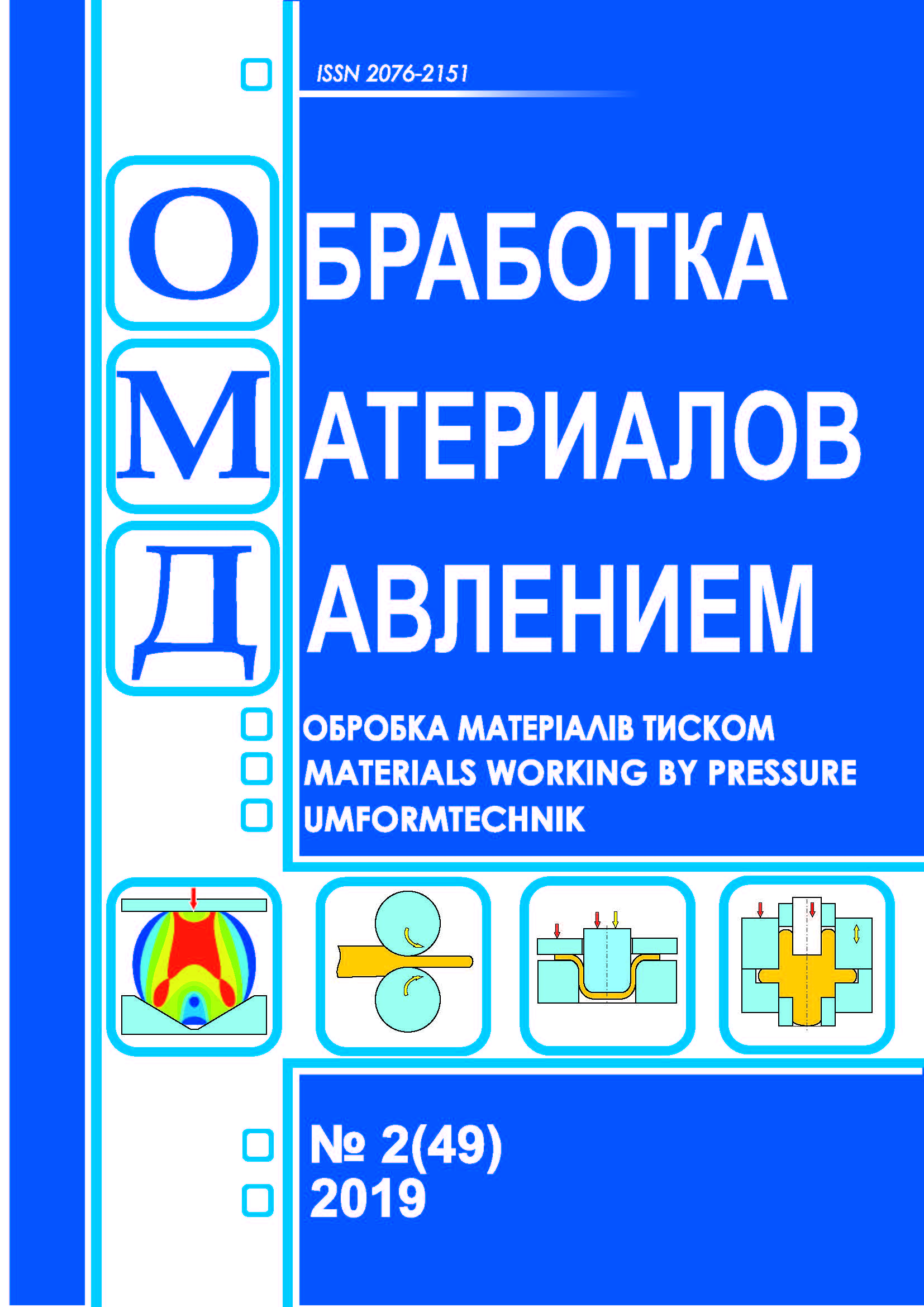Investigation of the influence of the basic parameters of the rolling-ECAP process on the stress-strain state and evolution of the microstructure using computer simulation
DOI:
https://doi.org/10.37142/2076-2151/2019-2(49)26Keywords:
rolling – ECAP; combined process; simulation; stress; strain; grain size; Deform-3D; simufact forming.Abstract
Naizabekov A. B., Lezhnev S. N., Panin E. A. Investigation of the influence of the basic parameters of the rolling-ECAP process on the stress-strain state and evolution of the microstructure using computer simulation // Material working by pressure. – 2019. – № 2 (49). - Р. 26-34.
The paper presents the results of computer simulation of the combined process, which combines longitudinal rolling and equal-channel angular pressing (ECAP). The simulation was carried out in the program Deform-3Dto assess the impact of the main parameters of the process on the stress-strain state. Analysis of the influence of various factors on the stress and strain state of the process showed that such factors as the junction angle of the matrix channels and the workpiece heating temperature have a significant impact on the distribution of stresses and accumulated deformation throughout the volume of the workpiece in the implementation of the combined process "rolling-ECAP". At the same time, the variation of the values of the friction coefficients and the lengths of the matrix channels within the permissible values does not play a significant role in changing the SSS parameters in this combined process. As a result of studying the microstructure evolution after modeling in the Simufact Forming program, it was found that the combined method "rolling-ECAP" allows to significantly grind the initial grain size. It is established that the influence of the workpiece heating temperature plays a significant role in the degree of grain grinding. In order to reduce the spread of values and alignment of grain size across the section, it is necessary to subject the workpiece to several deformation cycles. After the third pass, the average grain size difference between the central and surface zones is only 3 μm, which is much smaller than that after the first pass (7 μm). This allows us to talk about a fairly uniform study of the structure of the cross section of the workpiece.
References
Raab G.I., Raab A.G., Zhilyaev A.P. Gradient structure and methods for their preparation. Proceed-ings of the 16th International Congress «Machines, Technologies, Materials». 2019, Vol. I “Technologies”, pp. 132-133.
Naizabekov A., Lezhnev S., Panin E., Arbuz A. Combined process “helical rolling-pressing” and its effect on the microstructure of ferrous and non-ferrous materials. Metallurgical Research & Technology. 2018, 115, 213. pp. 11- 19. DOI: https://doi.org/10.1051/metal/2017099
Mochalin I.V., Gorokhov Yu.V., Belyaev S.V., Gubanov I.Yu. Extrusion copper bus bars at the installation "Conform" with prechamber. Nonferrous metals. 2016, 5, pp. 75-78.
Pat. № 27262 RK. Device for continuous pressing of metals and alloys. Naizabekov A.B., Lezhnev S.N., Panin E.A. 2016.
Pat. № 25862 RK. Device for continuous pressing of metals and alloys. Naizabekov A.B., Lezhnev S.N., Panin E.A. 2013.
Naizabekov A., Lezhnev S., Panin E., Koinov T. Theoretical grounds of the combined “rolling - equal - channel step pressing” process. Journal of Chemical Technology and Metallurgy. 2016, 51, 5, pp. 594-602.
Naizabekov A., Lezhnev S., Panin E., Volokitina I. New combined technology of deformation “rolling-equal channel angular pressing”. In Book: Severe Plastic Deformation Techniques. Ed. M. Cabibbo. 2017. DOI: https://doi.org/10.5772/intechopen.68663
Fastikovsky A.R. Evaluation of the capabilities of the rolling process–pressing. Forging and stamping Pro-duction. 2004, 2, pp. 3-6. (in Russian).
Valiev R.Z., Islamgaliev R.K., Alexandrov I.V. Bulk nanostructured materials from severe plastic defor-mation. Progress in Materials Science. 2000, 45(2), pp. 103-189.
Valiev R.Z., Langdon T.G. Principles of equal-channel angular pressing as a processing tool for grain re-finement. Progress in Materials Science. 2006, 51, pp. 881–981.
Yada H., Matsuzu N., Nakajima K., Watanabe K., Tokita H. Strength and structural-changes under high strain-rate hot deformation of C-steels. Transactions of the Iron and Steel Institute of Japan. 1983, 23, 2, pp. 100-109.

